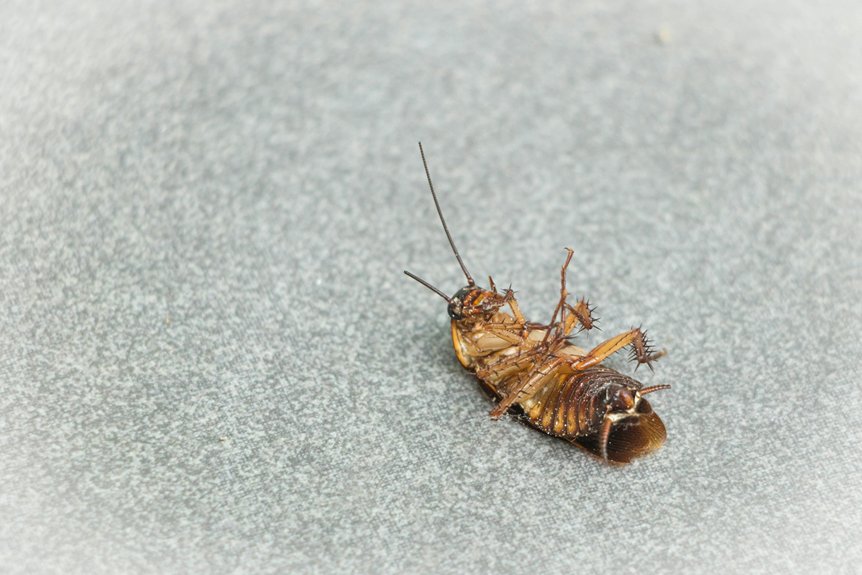Imagine discovering a flying cockroach buzzing around your kitchen late at night. It’s not just unsettling; it signals a potential infestation. To tackle this issue effectively, you need to understand their habits and how they enter your home. By following a few targeted strategies, you can greatly reduce their presence and keep your living space comfortable. Let’s explore the best methods to reclaim your home from these unwelcome pests.
Key Takeaways
- Seal all cracks and gaps in walls, doors, and windows to prevent entry points for flying cockroaches.
- Maintain cleanliness by regularly cleaning food areas and storing food in airtight containers.
- Fix any plumbing leaks promptly to reduce moisture, which attracts cockroaches.
- Use natural remedies like essential oils, diatomaceous earth, or vinegar sprays to deter cockroaches.
- Call professional exterminators if you notice significant cockroach presence or if DIY methods fail after a few weeks.
Understanding the Flying Cockroach
Flying cockroaches, often referred to as “palmetto bugs,” can be a startling sight, especially when they invade your living space.
Understanding their behavior is essential for effective management. These cockroaches are nocturnal, emerging at night to search for food and water. Their flying characteristics allow them to cover considerable distances, which can make them difficult to catch.
They prefer warm, humid environments, often nesting near plumbing or heating sources. Recognizing these traits can help you identify potential entry points and breeding grounds, enabling you to take proactive measures against their presence in your home.
Identifying the Common Types of Flying Cockroaches
While many might think of all flying cockroaches as the same, several species have distinct characteristics that can help you identify them.
The American Cockroach is large, with reddish-brown wings and a yellowish figure behind its head.
The German Cockroach is smaller, light brown, and has two dark stripes on its back.
The Brown Banded Cockroach features a lighter coloration with distinct brown bands across its wings.
Finally, the Oriental Cockroach is dark, almost black, and has shorter wings.
Knowing these traits can assist you in recognizing which flying cockroach you’re dealing with and determining your next steps for control.
Why Do Cockroaches Fly?
Understanding the types of flying cockroaches is just the beginning; it’s also important to know why they take to the air. Cockroaches fly primarily for survival and reproduction, showcasing their flying capabilities when escaping predators or finding mates. Their behavior can be influenced by environmental factors like warmth and humidity, which encourage flight.
| Reason | Description | Impact on Behavior |
|---|---|---|
| Escape Predators | Flying helps them evade threats | Increases survival chances |
| Mating Rituals | Males may fly to attract females | Aids in reproduction |
| Environmental Factors | Warmth and humidity trigger flight responses | Promotes movement to suitable areas |
Preventative Measures to Keep Them Away
To effectively keep flying cockroaches away, you need to create an environment that discourages their presence.
Start with cockroach proofing techniques, like sealing cracks and gaps in walls, doors, and windows.
Make certain that your home maintenance includes regular cleaning, focusing on areas where food particles accumulate.
Fix leaks promptly to eliminate moisture, as cockroaches thrive in damp environments.
Remove clutter and debris, which can serve as hiding spots.
Store food in airtight containers and take out the trash regularly.
Natural Remedies for Flying Cockroaches
If you’re looking for natural ways to tackle flying cockroaches, several effective remedies can help.
Essential oils like peppermint and eucalyptus work as strong repellents, while diatomaceous earth can disrupt their exoskeletons.
A simple vinegar and water spray also serves as a deterrent when applied to problem areas.
Essential Oils Repellents
While you may be looking for effective ways to keep flying cockroaches at bay, essential oils can serve as powerful natural repellents. The essential oil benefits include their ability to deter these pests with pleasant scents.
You can easily create DIY repellent recipes using oils like peppermint, tea tree, or eucalyptus. Simply mix 10-15 drops of your chosen oil with water in a spray bottle and apply it around entry points and infested areas. Regular application can enhance effectiveness.
Diatomaceous Earth Application
Diatomaceous earth (DE) offers a powerful and natural way to combat flying cockroaches in your home. Its effectiveness comes from the tiny, sharp particles that damage the exoskeletons of these pests, leading to dehydration and death.
For the best results, apply DE in areas where you’ve spotted cockroaches, such as cracks, crevices, and along baseboards. Use a dust applicator for even distribution, ensuring you cover potential entry points.
Remember to reapply after cleaning or if it gets wet. With proper diatomaceous earth application, you can greatly reduce the flying cockroach population in your living space.
Vinegar and Water Spray
One effective solution for tackling flying cockroaches is a simple vinegar and water spray. This natural remedy harnesses vinegar’s effectiveness to repel and eliminate these pests. Mix equal parts vinegar and water in a spray bottle, then apply it to areas where you’ve spotted cockroaches. The strong scent disrupts their habitat, making your space less inviting.
| Ingredients | Purpose |
|---|---|
| Vinegar (1 part) | Repels flying cockroaches |
| Water (1 part) | Dilutes vinegar for safe use |
| Spray Bottle | Easy application |
Try this method for a pest-free environment!
Chemical Solutions and Insecticides
Chemical solutions and insecticides are often the most effective ways to tackle flying cockroaches. You’ll find various chemical formulations available, ranging from sprays to baits, specifically designed to eliminate these pests.
When choosing an insecticide, always prioritize insecticide safety; read labels carefully to verify it’s safe for your home and family. Follow application instructions meticulously to maximize effectiveness and minimize risks.
Consider using products that target cockroaches while being less harmful to beneficial insects. Keep your living spaces ventilated during and after application.
Regularly check for any signs of reinfestation to maintain a cockroach-free environment.
Setting Traps for Effective Capture
While chemical solutions can effectively eliminate flying cockroaches, setting traps provides a proactive approach to capture and monitor these pests.
You can choose from various trap types, such as sticky traps or bait traps. Sticky traps are easy to use and can be placed in areas where you’ve spotted cockroaches. Bait traps lure them in with enticing bait options like peanut butter or sugar-water solutions.
Position traps near entry points and dark corners for maximum effectiveness. Regularly check and replace traps to guarantee they remain effective.
This method not only captures cockroaches but also helps you gauge the severity of the infestation.
Maintaining Cleanliness to Deter Infestations
To effectively deter flying cockroach infestations, maintaining cleanliness in your home is essential. Establishing regular cleaning routines helps eliminate food crumbs and spills that attract these pests.
Focus on areas like kitchens and dining spaces, where debris often accumulates. Additionally, clutter reduction is vital; cockroaches thrive in disorganized spaces, so keep your home tidy and organized.
Store food in sealed containers, and promptly dispose of garbage. Regularly vacuum and wipe surfaces to maintain a hygienic environment.
When to Call Professional Exterminators
Even with a clean home, you might still find yourself facing a flying cockroach problem that’s beyond your control.
If you notice several cockroaches, especially during the day, that’s a clear sign of infestation. You should seek professional help when DIY methods fail to make an impact after a few weeks.
Additionally, if you spot droppings, egg cases, or a musty odor, it’s time to act. Don’t wait for the problem to escalate; professionals can quickly assess the situation and implement effective treatments.
Long-term Strategies for a Cockroach-Free Home
Establishing long-term strategies is essential for maintaining a cockroach-free home.
By focusing on sustainable practices and consistent long-term maintenance, you can greatly reduce the risk of infestations.
Here are some effective strategies:
- Seal cracks and crevices to eliminate potential entry points.
- Keep your kitchen clean and free of food debris, ensuring all food is stored properly.
- Regularly inspect and maintain plumbing to prevent leaks that attract cockroaches.
Implementing these measures will create an environment that’s less inviting for cockroaches, allowing you to enjoy a pest-free home for the long haul.
Conclusion
By taking proactive steps to eliminate flying cockroaches, you can reclaim your space and peace of mind. But don’t let your guard down—these pests are persistent. Regularly check for cracks, maintain cleanliness, and consider natural remedies. If the problem escalates, it’s best to call in the professionals before they multiply. Remember, the longer you wait, the more challenging it becomes to get rid of them. Stay vigilant, and keep your home a cockroach-free sanctuary.




